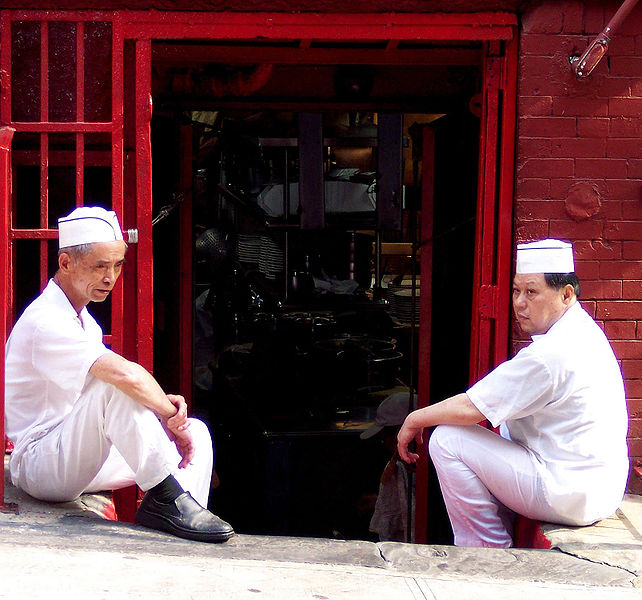I feel like I woke up in the first row at an action movie and the screen opened up to pour forth a screaming cast of thousands.
The day began with climbing, swirling noise—fire engines and patrol cars and helicopters racing around our pillows. I was at Anna’s place near the Manhattan Bridge, on the northeast edge of Chinatown, and there was a major emergency not far away. We couldn’t see anything from her southern exposure but when we heard explosions, we threw on some clothes and headed early to the demonstration at City Hall.
There was a strong eastern breeze and the noise was to the west—like the chaos we all heard on 9/11. Had New York been attacked again?
 CHINATOWN COOKS, BEFORE THE FIRESTORM (Uris)Before Anna and I got to Park Row, we started to see people milling around. They were Chinese, wearily sitting on stoops and cars with arms full of stuff, trying to keep track of old people and children. Many were weeping. People carried water to them. Everyone was holding cell phones but no one was talking or texting. Had the city shut the transmitters off? Had terrorists blown them up?
CHINATOWN COOKS, BEFORE THE FIRESTORM (Uris)Before Anna and I got to Park Row, we started to see people milling around. They were Chinese, wearily sitting on stoops and cars with arms full of stuff, trying to keep track of old people and children. Many were weeping. People carried water to them. Everyone was holding cell phones but no one was talking or texting. Had the city shut the transmitters off? Had terrorists blown them up?
There was a lot of smoke. Cinders circled like snowflakes.
We didn’t want to stare, so we tightened our masks and moved on.
A convoy of National Guards rumbled past us to head up the Bowery, weapons ready … for what? The crowd hadn’t looked criminal.
The uniformed men and women were craning their necks like tourists, pointing out sights. They looked more surprised than sanguine. Had the city come unraveled while it closed our little food service? Was there a mighty displeased Almighty up there?
Our cellular circuits were indeed jammed. No headlines, no messages, no voices.
Near City Hall we found office workers chain-smoking cigarettes. They said that the heart of Chinatown was burning and the city had quickly run out of firefighters. The National Guards we had seen were deployed from Connecticut to fight a mega-alarm fire in the warren of tenements and crooked streets between Canal Street and Park Row, from Centre Street to the Bowery.
Untrained and poorly equipped, those Guards are said to have tried valiantly. What could they do in narrow lanes full of exploding parked cars as flames vaulted overhead from block to block, igniting century-old tinderboxes—each of which might contain hundreds living in bunked cubicles? Fourteen of the Guards we saw are missing.
Of course there was no LES DIY demonstration. Not even the cops showed up.
We stood around East Broadway in a daze, trying to stay out of the way. Helicopters were dumping water as if on one of those fiery windstorms that are devastating Southern California. Chinese women wailed or stood silently near us. Then a brisk line of emergency workers carrying black bags emerged from the ruins: body bags. They were clearing dead victims.
I held Anna as the grim parade approached us. After a few men came a woman holding a small white bag that must have contained a child. Anna twitched as if she’d been shocked and then crumpled into unconsciousness. I carried her to a stoop on Hester Street as if she were a child. We rested as she cried. I couldn’t hear her amid the noise but she trembled like a bird.
A few of the survivors have taken shelter in schools that haven’t yet been turned into flu wards. The East Village is full of smoke and flugitives bearing little bundles. Today, I cherished mine, even as she pleaded in vain for me to take her home so she could prepare food for the old people. Sorry, no LES DIY tonight.